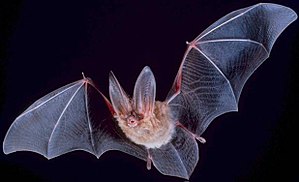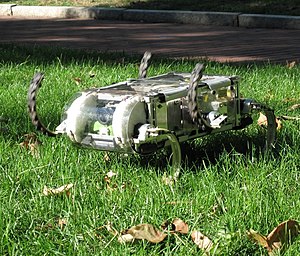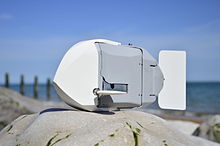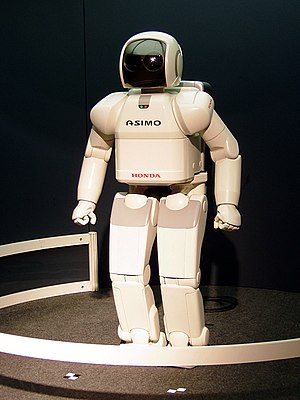Bio-inspired robotics
This article has multiple issues. Please help improve it or discuss these issues on the talk page. (Learn how and when to remove these messages)
|

Bio-inspired robotic locomotion is a subcategory of bio-inspired design. It is about learning concepts from nature and applying them to the design of real-world engineered systems. More specifically, this field is about making robots that are inspired by biological systems, including Biomimicry. Biomimicry is copying from nature while bio-inspired design is learning from nature and making a mechanism that is simpler and more effective than the system observed in nature. Biomimicry has led to the development of a different branch of robotics called soft robotics. The biological systems have been optimized for specific tasks according to their habitat. However, they are multifunctional and are not designed for only one specific functionality. Bio-inspired robotics is about studying biological systems, and looking for the mechanisms that may solve a problem in the engineering field. The designer should then try to simplify and enhance that mechanism for the specific task of interest. Bio-inspired roboticists are usually interested in biosensors (e.g. eye), bioactuators (e.g. muscle), or biomaterials (e.g. spider silk). Most of the robots have some type of locomotion system. Thus, in this article different modes of animal locomotion and few examples of the corresponding bio-inspired robots are introduced.

Biolocomotion
[edit]Biolocomotion or animal locomotion is usually categorized as below:
Locomotion on a surface
[edit]Locomotion on a surface may include terrestrial locomotion and arboreal locomotion. We will specifically discuss about terrestrial locomotion in detail in the next section.

Locomotion in a fluid
[edit]Locomotion in a blood stream or cell culture media swimming and flying. There are many swimming and flying robots designed and built by roboticists.[1] Some of them use miniaturized motors or conventional MEMS actuators (such as piezoelectric, thermal, magnetic, etc),[2][3][4] while others use animal muscle cells as motors.[5][6][7]
Behavioral classification (terrestrial locomotion)
[edit]There are many animal and insects moving on land with or without legs. We will discuss legged and limbless locomotion in this section as well as climbing and jumping. Anchoring the feet is fundamental to locomotion on land. The ability to increase traction is important for slip-free motion on surfaces such as smooth rock faces and ice, and is especially critical for moving uphill. Numerous biological mechanisms exist for providing purchase: claws rely upon friction-based mechanisms; gecko feet upon van der walls forces; and some insect feet upon fluid-mediated adhesive forces.[8]

Legged locomotion
[edit]Legged robots may have one,[9][10][11] two,[12] four,[13] six,[14][15][16] or many legs[17] depending on the application. One of the main advantages of using legs instead of wheels is moving on uneven environment more effectively. Bipedal, quadrupedal, and hexapedal locomotion are among the most favorite types of legged locomotion in the field of bio-inspired robotics. Rhex, a Reliable Hexapedal robot[14] and Cheetah[18] are the two fastest running robots so far. iSprawl is another hexapedal robot inspired by cockroach locomotion that has been developed at Stanford University.[15] This robot can run up to 15 body length per second and can achieve speeds of up to 2.3 m/s. The original version of this robot was pneumatically driven while the new generation uses a single electric motor for locomotion.[16]
Limbless locomotion
[edit]Terrain involving topography over a range of length scales can be challenging for most organisms and biomimetic robots. Such terrain are easily passed over by limbless organisms such as snakes. Several animals and insects including worms, snails, caterpillars, and snakes are capable of limbless locomotion. A review of snake-like robots is presented by Hirose et al.[19] These robots can be categorized as robots with passive or active wheels, robots with active treads, and undulating robots using vertical waves or linear expansions. Most snake-like robots use wheels, which are high in friction when moving side to side but low in friction when rolling forward (and can be prevented from rolling backward). The majority of snake-like robots use either lateral undulation or rectilinear locomotion and have difficulty climbing vertically. Choset has recently developed a modular robot that can mimic several snake gaits, but it cannot perform concertina motion.[20] Researchers at Georgia Tech have recently developed two snake-like robots called Scalybot. The focus of these robots is on the role of snake ventral scales on adjusting the frictional properties in different directions. These robots can actively control their scales to modify their frictional properties and move on a variety of surfaces efficiently.[21] Researchers at CMU have developed both scaled[22] and conventional actuated snake-like robots.[23]
Climbing
[edit]Climbing is an especially difficult task because mistakes made by the climber may cause the climber to lose its grip and fall. Most robots have been built around a single functionality observed in their biological counterparts. Geckobots typically use van der waals forces that work only on smooth surfaces.[24] Being inspired from geckos, scientists from Stanford university have artificially created the adhesive property of a gecko. Similar to seta in a gecko's leg, millions of microfibers were placed and attached to a spring. The tip of the microfiber will be sharp and pointed in usual circumstances, but upon actuation, the movement of a spring will create a stress which bends these microfibers and increase their contact area to the surface of a glass or wall. Using the same technology, gecko grippers were invented by NASA scientists for different applications in space. Stickybots use directional dry adhesives that works best on smooth surfaces.[25][26][27][28][29] The Spinybot[30] and RiSE[31] robots are among the insect-like robots that use spines instead. Legged climbing robots have several limitations. They cannot handle large obstacles since they are not flexible and they require a wide space for moving. They usually cannot climb both smooth and rough surfaces or handle vertical to horizontal transitions as well.
Jumping
[edit]One of the tasks commonly performed by a variety of living organisms is jumping. Bharal, hares, kangaroo, grasshopper, flea, and locust are among the best jumping animals. A miniature 7g jumping robot inspired by locust has been developed at EPFL that can jump up to 138 cm.[32] The jump event is induced by releasing the tension of a spring. The highest jumping miniature robot is inspired by the locust, weighs 23 grams with its highest jump to 365 cm is "TAUB" (Tel-Aviv University and Braude College of engineering).[33] It uses torsion springs as energy storage and includes a wire and latch mechanism to compress and release the springs. ETH Zurich has reported a soft jumping robot based on the combustion of methane and laughing gas.[34] The thermal gas expansion inside the soft combustion chamber drastically increases the chamber volume. This causes the 2 kg robot to jump up to 20 cm. The soft robot inspired by a roly-poly toy then reorientates itself into an upright position after landing.
Behavioral classification (aquatic locomotion)
[edit]Swimming (piscine)
[edit]It is calculated that when swimming some fish can achieve a propulsive efficiency greater than 90%.[35] Furthermore, they can accelerate and maneuver far better than any man-made boat or submarine, and produce less noise and water disturbance. Therefore, many researchers studying underwater robots would like to copy this type of locomotion.[36] Notable examples are the Essex University Computer Science Robotic Fish G9,[37] and the Robot Tuna built by the Institute of Field Robotics, to analyze and mathematically model thunniform motion.[38] The Aqua Penguin,[39] designed and built by Festo of Germany, copies the streamlined shape and propulsion by front "flippers" of penguins. Festo have also built the Aqua Ray and Aqua Jelly, which emulate the locomotion of manta ray, and jellyfish, respectively.

In 2014, iSplash-II was developed by PhD student Richard James Clapham and Prof. Huosheng Hu at Essex University. It was the first robotic fish capable of outperforming real carangiform fish in terms of average maximum velocity (measured in body lengths/ second) and endurance, the duration that top speed is maintained.[40] This build attained swimming speeds of 11.6BL/s (i.e. 3.7 m/s).[41] The first build, iSplash-I (2014) was the first robotic platform to apply a full-body length carangiform swimming motion which was found to increase swimming speed by 27% over the traditional approach of a posterior confined waveform.[42]
Morphological classification
[edit]Modular
[edit]
The modular robots are typically capable of performing several tasks and are specifically useful for search and rescue or exploratory missions. Some of the featured robots in this category include a salamander inspired robot developed at EPFL that can walk and swim,[43] a snake inspired robot developed at Carnegie-Mellon University that has four different modes of terrestrial locomotion,[20] and a cockroach inspired robot can run and climb on a variety of complex terrain.[14]
Humanoid
[edit]Humanoid robots are robots that look human-like or are inspired by the human form. There are many different types of humanoid robots for applications such as personal assistance, reception, work at industries, or companionship. These type of robots are used for research purposes as well and were originally developed to build better orthosis and prosthesis for human beings. Petman is one of the first and most advanced humanoid robots developed at Boston Dynamics. Some of the humanoid robots such as Honda Asimo are over actuated.[44] On the other hand, there are some humanoid robots like the robot developed at Cornell University that do not have any actuators and walk passively descending a shallow slope.[45]
Swarming
[edit]The collective behavior of animals has been of interest to researchers for several years. Ants can make structures like rafts to survive on the rivers. Fish can sense their environment more effectively in large groups. Swarm robotics is a fairly new field and the goal is to make robots that can work together and transfer the data, make structures as a group, etc.[46]
Soft
[edit]Soft robots[47] are robots composed entirely of soft materials and moved through pneumatic pressure, similar to an octopus or starfish. Such robots are flexible enough to move in very limited spaces (such as in the human body). The first multigait soft robots was developed in 2011[48] and the first fully integrated, independent soft robot (with soft batteries and control systems) was developed in 2015.[49]
See also
[edit]- Animal locomotion
- Biomimetics
- Biorobotics
- Biomechatronics
- Biologically inspired engineering
- Robotic materials
- Lists of types of robots
References
[edit]- ^ Oliveira Santos, Sara; Tack, Nils; Su, Yunxing; Cuenca-Jimenez, Francisco; Morales-Lopez, Oscar; Gomez-Valdez, P. Antonio; M Wilhelmus, Monica (June 13, 2023). "Pleobot: a modular robotic solution for metachronal swimming". Scientific Reports. 13 (1): 9574. Bibcode:2023NatSR..13.9574O. doi:10.1038/s41598-023-36185-2. PMC 10264458. PMID 37311777.
- ^ R. Fearing, S. Avadhanula, D. Campolo, M. Sitti, J. Jan, and R. Wood, "A micromechanical flying insect thorax," Neurotechnology for Biomimetic Robots, pp. 469–480, 2002.
- ^ G. Dudek, M. Jenkin, C. Prahacs, A. Hogue, J. Sattar, P. Giguere, A. German, H. Liu, S. Saun- derson, A. Ripsman, et al., "A visually guided swimming robot," in IEEE/RSJ International Conference on Intelligent Robots and Systems, IROS, pp. 3604–3609, 2005.
- ^ A. Alessi, A. Sudano, D. Accoto, E. Guglielmelli, "Development of an autonomous robotic fish," In Biomedical Robotics and Biomechatronics (BioRob), 2012 4th IEEE RAS & EMBS International Conference on (pp. 1032-1037). IEEE.
- ^ Nawroth; et al. (2012). "A tissue-engineered jellyfish with biomimetic propulsion". Nature Biotechnology. 30 (8): 792–797. doi:10.1038/nbt.2269. PMC 4026938. PMID 22820316.
- ^ Park; et al. (2016). "Phototactic guidance of a tissue-engineered soft-robotic ray". Science. 353 (6295): 158–162. Bibcode:2016Sci...353..158P. doi:10.1126/science.aaf4292. PMC 5526330. PMID 27387948.
- ^ Shin; et al. (2018). "Electrically Driven Microengineered Bioinspired Soft Robots". Advanced Materials. 30 (10): 1704189. Bibcode:2018AdM....3004189S. doi:10.1002/adma.201704189. PMC 6082116. PMID 29323433.
- ^ R. M. Alexander, Principles of animal locomotion. Princeton University Press, 2003
- ^ M. H. Raibert, H. B. Brown, "Experiments in balance with a 2D one-legged hopping machine," ASME Journal of Dynamic Systems, Measurement, and Control, pp75-81, 1984.
- ^ M. Ahmadi and M. Buehler, "Stable control of a simulated one-legged running robot with hip and leg compliance," IEEE Transactions on Robotics and Automation, vol. 13, no. 1, pp. 96– 104, 1997.
- ^ P. Gregorio, M. Ahmadi, and M. Buehler, "Design, control, and energetics of an electrically actuated legged robot," IEEE Transactions on Systems, Man, and Cybernetics, Part B: Cybernetics, vol. 27, no. 4, pp. 626–634, 1997.
- ^ R. Niiyama, A. Nagakubo, and Y. Kuniyoshi, "Mowgli: A bipedal jumping and landing robot with an artificial musculoskeletal system," in IEEE International Conference on Robotics and Automation, pp. 2546–2551, 2007.
- ^ M. Raibert, K. Blankespoor, G. Nelson, R. Playter, et al., "Bigdog, the rough-terrain quadruped robot," in Proceedings of the 17th World Congress, pp. 10823–10825, 2008.
- ^ a b c U. Saranli, M. Buehler, and D. Koditschek, "Rhex: A simple and highly mobile hexapod robot," The International Journal of Robotics Research, vol. 20, no. 7, pp. 616–631, 2001.
- ^ a b J. Clark, J. Cham, S. Bailey, E. Froehlich, P. Nahata, M. Cutkosky, et al., "Biomimetic design and fabrication of a hexapedal running robot," in Robotics and Automation, 2001. Proceedings 2001 ICRA. IEEE International Conference on, vol. 4, pp. 3643–3649, 2001.
- ^ a b S. Kim, J. Clark, and M. Cutkosky, "isprawl: Design and tuning for high-speed autonomous open-loop running," The International Journal of Robotics Research, vol. 25, no. 9, pp. 903– 912, 2006.
- ^ S. Wakimoto, K. Suzumori, T. Kanda, et al., "A bio-mimetic amphibious soft cord robot," Transactions of the Japan Society of Mechanical Engineers Part C, vol. 18, no. 2, pp. 471–477, 2006.
- ^ Y. Li, B. Li, J. Ruan, and X. Rong, "Research of mammal bionic quadruped robots: A review," in Robotics, IEEE Conference on Automation and Mechatronics, pp. 166–171, 2011.
- ^ S. Hirose, P. Cave, and C. Goulden, Biologically inspired robots: snake- like locomotors and manipulators, vol. 64. Oxford University Press Oxford, UK, 1993
- ^ a b R. Hatton and H. Choset, "Generating gaits for snake robots: annealed chain fitting and keyframe wave extraction," Autonomous Robots, vol. 28, no. 3, pp. 271–281, 2010.
- ^ H. Marvi, G. Meyers, G. Russell, D. Hu, "Scalybot: a Snake-inspired Robot with Active Frictional Anisotropy," ASME Dynamic Systems and Control Conference, Arlington, VA, 2011.
- ^ Simon, Matt (February 21, 2010). "Snakelike Skin Gives a Robot the Power to Crawl". Wired.
- ^ Simon, Matt (November 2, 2017). "This Robot Snake Means You No Harm, Really". Wired.
- ^ O. Unver, A. Uneri, A. Aydemir, and M. Sitti, "Geckobot: a gecko inspired climbing robot using elastomer adhesives," in International Conference on Robotics and Automation, pp. 2329–2335, 2006.
- ^ S. Kim, M. Spenko, S. Trujillo, B. Heyneman, D. Santos, and M. Cutkosky, "Smooth vertical surface climbing with directional adhesion," IEEE Transactions on Robotics, vol. 24, no. 1, pp. 65–74, 2008.
- ^ S. Kim, M. Spenko, S. Trujillo, B. Heyneman, V. Mattoli, and M. Cutkosky, "Whole body adhesion: hierarchical, directional and distributed control of adhesive forces for a climbing robot," in IEEE International Conference on Robotics and Automation, pp. 1268–1273, 2007.
- ^ D. Santos, B. Heyneman, S. Kim, N. Esparza, and M. Cutkosky, "Gecko-inspired climbing behaviors on vertical and overhanging surfaces," in IEEE International Conference on Robotics and Automation, pp. 1125–1131, 2008.
- ^ A. Asbeck, S. Dastoor, A. Parness, L. Fullerton, N. Esparza, D. Soto, B. Heyneman, and M. Cutkosky, "Climbing rough vertical surfaces with hierarchical directional adhesion," in IEEE International Conference on Robotics and Automation, pp. 2675–2680, 2009.
- ^ S. Trujillo, B. Heyneman, and M. Cutkosky, "Constrained convergent gait regulation for a climbing robot," in IEEE International Conference on Robotics and Automation, pp. 5243–5249, 2010.
- ^ A. Asbeck, S. Kim, M. Cutkosky, W. Provancher, M. Lanzetta, "Scaling hard vertical surfaces with compliant microspine arrays," The International Journal of Robotics Research, Vol.25, No. 12, pp. 1165-1179, 2006.
- ^ M. Spenko, G. Haynes, J. Saunders, M. Cutkosky, A. Rizzi, D. Koditschek, et al., "Biologically inspired climbing with a hexapedal robot," Journal of Field Robotics, vol. 25, no. 4-5, pp. 223– 242, 2008.
- ^ M. Kovac, M. Fuchs, A. Guignard, J. Zufferey, and D. Floreano, "A miniature 7g jumping robot," in IEEE International Conference on Robotics and Automation, pp. 373–378, 2008.
- ^ V. Zaitsev, O. Gvirsman, U. Ben Hanan, A. Weiss, A. Ayali and G. Kosa, "A locust-inspired miniature jumping robot," in Bioinspiration & biomimetics, 10(6), p.066012.
- ^ M. Loepfe, C.M. Schumacher, U.B. Lustenberger, and W.J. Stark, "An Untethered, Jumping Roly-Poly Soft Robot Driven by Combustion," Soft Robotics, Vol. 2, No. 1, pp. 33-41, 2015.
- ^ Sfakiotakis; et al. (1999). "Review of Fish Swimming Modes for Aquatic Locomotion" (PDF). IEEE Journal of Oceanic Engineering. 24 (2): 237. Bibcode:1999IJOE...24..237S. doi:10.1109/48.757275. S2CID 17226211. Archived from the original (PDF) on 2007-09-26. Retrieved 2007-10-24.
- ^ Richard Mason. "What is the market for robot fish?". Archived from the original on 2009-07-04.
- ^ "Robotic fish powered by Gumstix PC and PIC". Human Centred Robotics Group at Essex University. Archived from the original on 2011-08-14. Retrieved 2007-10-25.
- ^ Witoon Juwarahawong. "Fish Robot". Institute of Field Robotics. Archived from the original on 2007-11-04. Retrieved 2007-10-25.
- ^ youtube.com
- ^ "High-Speed Robotic Fish | iSplash". isplash-robot. Retrieved 2017-01-07.
- ^ "iSplash-II: Realizing Fast Carangiform Swimming to Outperform a Real Fish" (PDF). Robotics Group at Essex University. Archived from the original (PDF) on 2015-09-30. Retrieved 2015-09-29.
- ^ "iSplash-I: High Performance Swimming Motion of a Carangiform Robotic Fish with Full-Body Coordination" (PDF). Robotics Group at Essex University. Archived from the original (PDF) on 2015-09-30. Retrieved 2015-09-29.
- ^ A. J. Ijspeert, A. Crespi, D. Ryczko and J.-M. Cabelguen, "From swimming to walking with a salamander robot driven by a spinal cord model," Science, vol. 315, num. 5817, p. 1416-1420, 2007.
- ^ K. Hirer, M. Hirose, Y. Haikawa, and T. Takenaka, "The development of honda humanoid robot," in IEEE International Conference on Robotics and Automation, vol. 2, pp. 1321–1326, 1998.
- ^ S. Collins, M. Wisse, and A. Ruina, "A three-dimensional passive-dynamic walking robot with two legs and knees," The International Journal of Robotics Research, vol. 20, no. 7, pp. 607–615, 2001.
- ^ E. S ̧ahin, "Swarm robotics: From sources of inspiration to domains of application," Swarm Robotics, pp. 10–20, 2005.
- ^ Trivedi, D., Rahn, C. D., Kier, W. M., & Walker, I. D. (2008). Soft robotics: Biological inspiration, state of the art, and future research. Applied Bionics and Biomechanics, 5(3), 99-117.
- ^ R. Shepherd, F. Ilievski, W. Choi, S. Morin, A. Stokes, A. Mazzeo, X. Chen, M. Wang, and G. Whitesides, "Multigait soft robot," Proceedings of the National Academy of Sciences, vol. 108, no. 51, pp. 20400–20403, 2011.
- ^ Webb, Jonathan (25 August 2016). "Pneumatic Octopus is first soft, solo robot". BBC News. Retrieved 25 August 2016.
External links
[edit]- The Soft Robotics Toolkit
- Boston Dynamics
- Research for this Wikipedia entry was conducted as a part of a Locomotion Neuromechanics course (APPH 6232) offered in the School of Applied Physiology at Georgia Tech
Research labs
[edit]- Poly-PEDAL Lab (Prof. Bob Full)
- Biomimetic Milisystems Lab (Prof. Ron Fearing)
- Biomimetics & Dexterous Manipulation Lab (Prof. Mark Cutkosky)
- Biomimetic Robotics Lab (Prof. Sangbae Kim)
- Harvard Microrobotics Lab (Prof. Rob Wood)
- Harvard Biodesign Lab (Prof. Conor Walsh)
- ETH Functional Material Lab (Prof. Wendelin Stark)
- Leg lab at MIT
- Center for Biologically Inspired Design at Georgia Tech
- Biologically Inspired Robotics Lab, Case Western Reserve University
- Biorobotics research group (S. Viollet/ F. Ruffier), Institute of Movement Science, CNRS/Aix-Marseille University (France)
- Center for Biorobotics, Tallinn University of Technology
- BioRob EPFL (Prof Auke Ijspeert)

